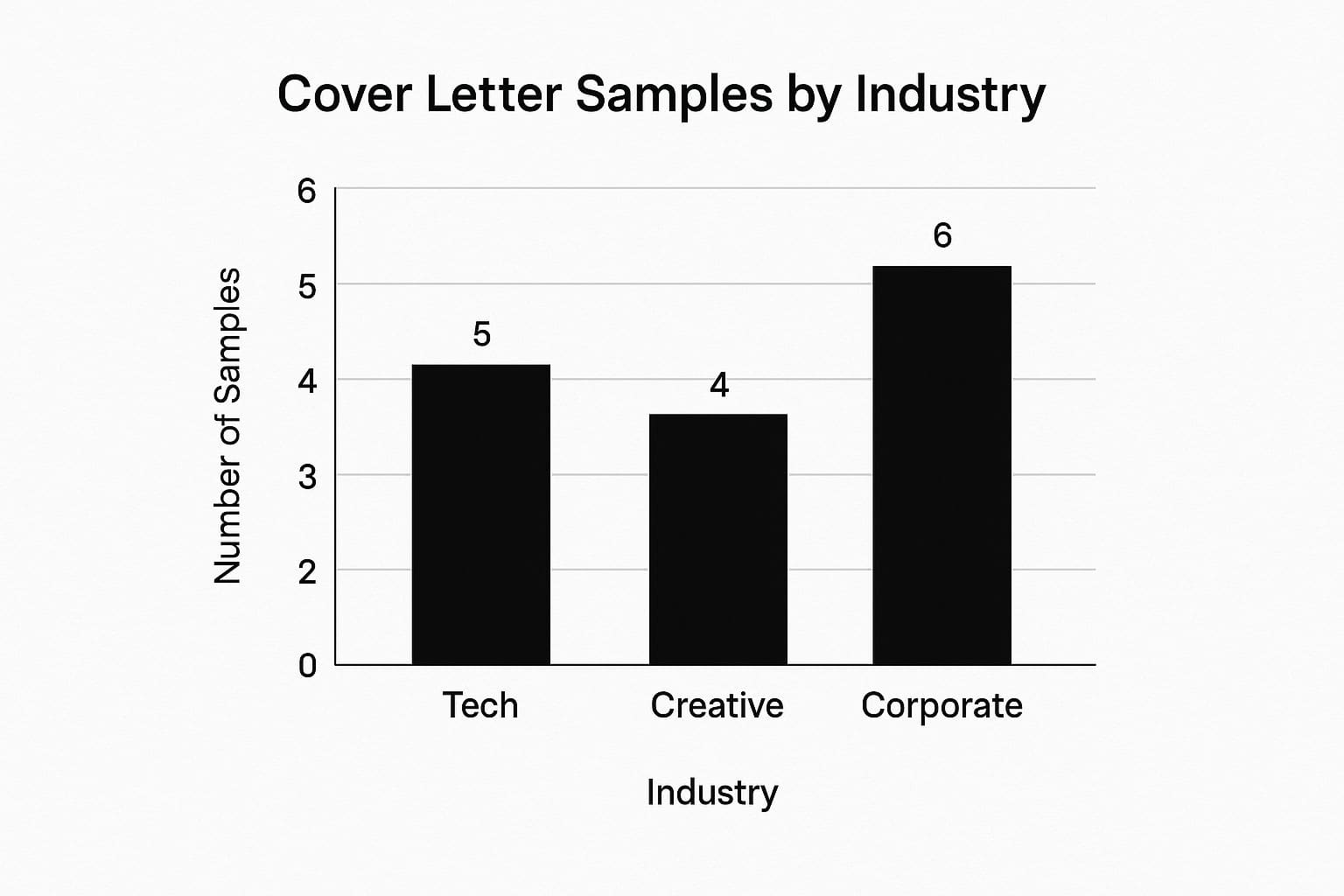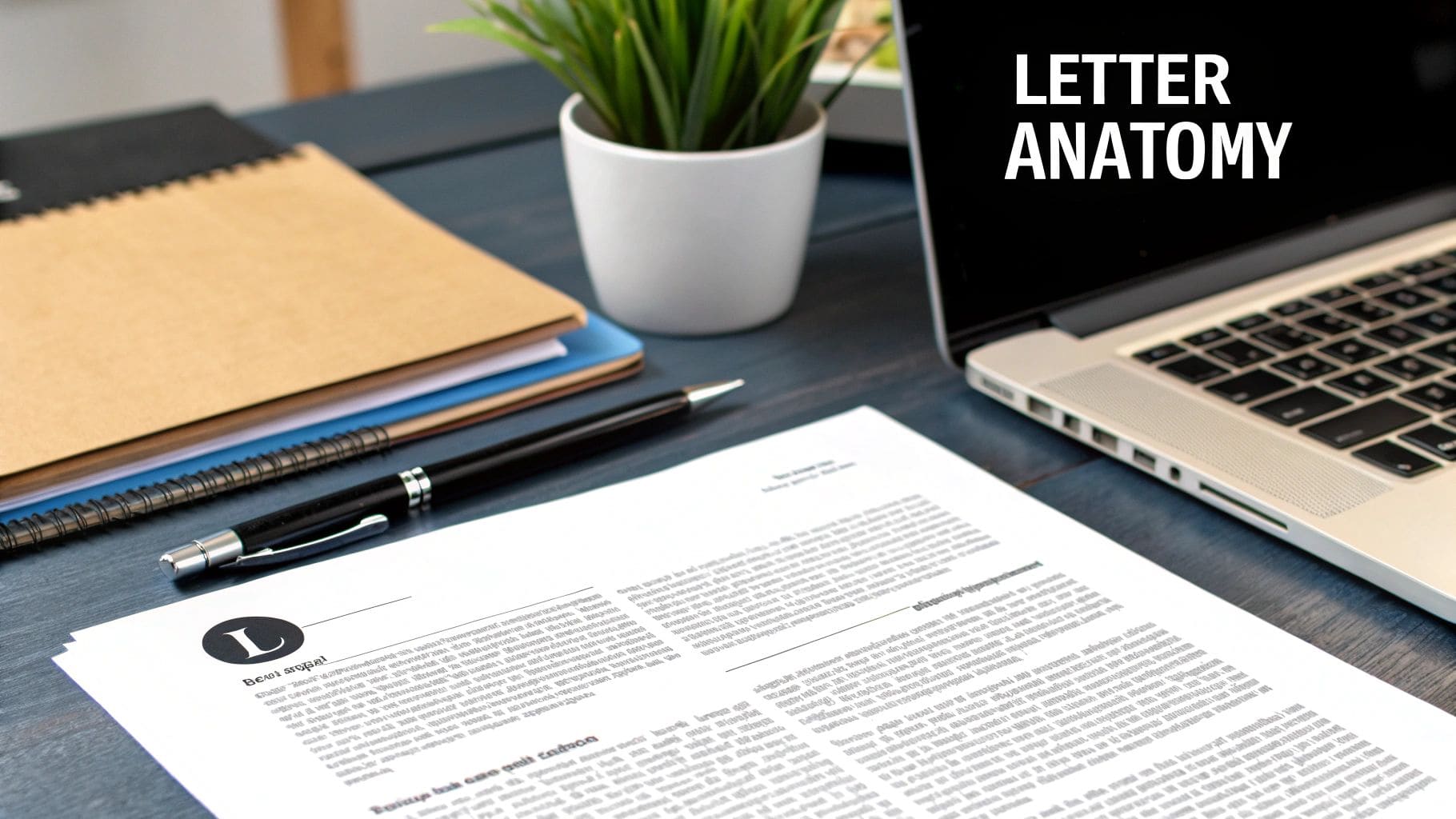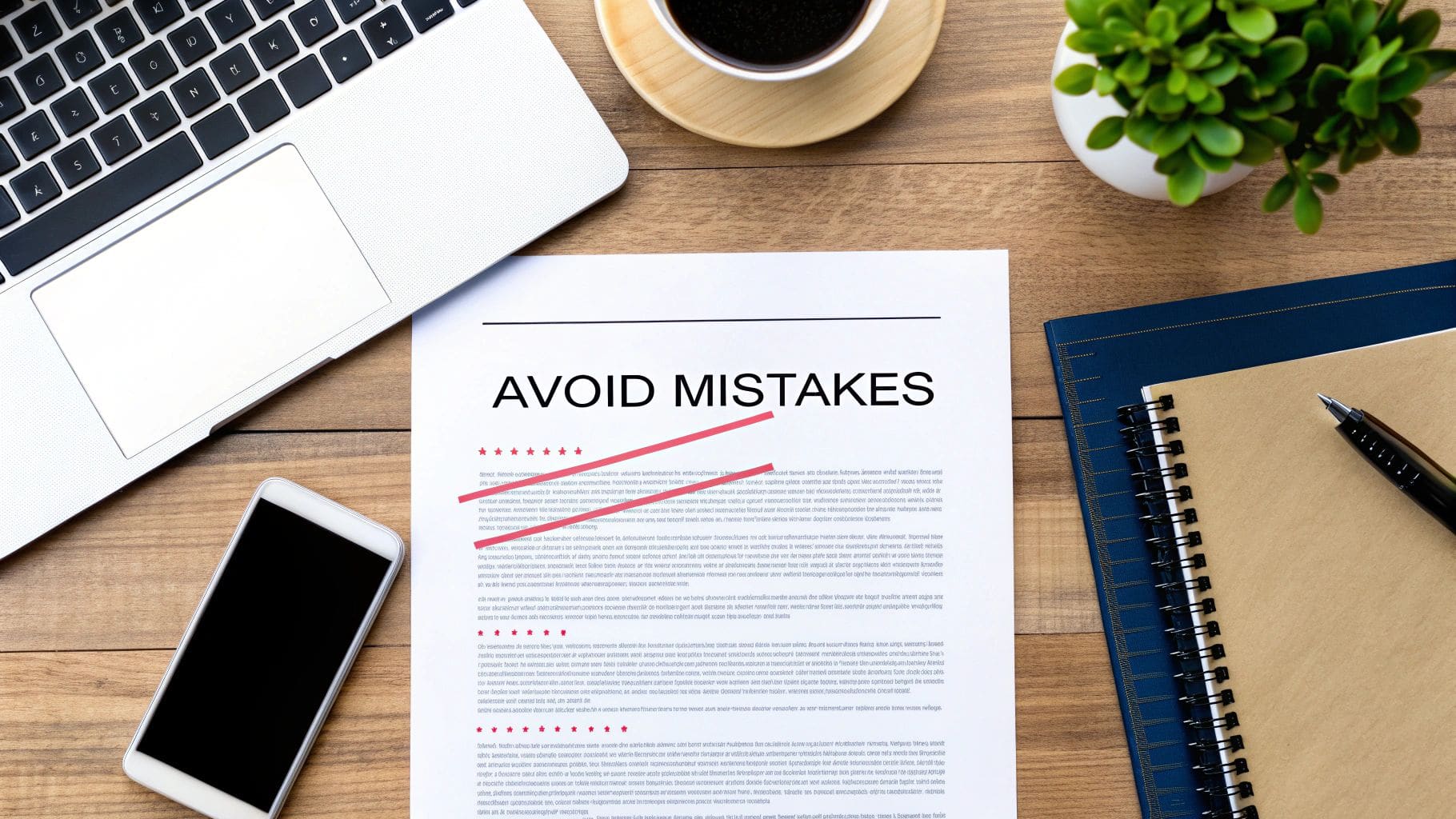Your Essential Cover Letter Sample Letter Guide
Find the perfect cover letter sample letter in our expert guide. Explore curated examples for any industry to help you land your next interview.
Your Essential Cover Letter Sample Letter Guide
A powerful cover letter sample letter isn't just a template; it's your roadmap to success. These expert examples provide a proven framework, showing you exactly how to structure your story to grab a hiring manager's attention and land that interview. They give you the confidence to move past the blank page and start writing with a clear purpose, ensuring your application stands out.
Your Essential Library of Cover Letter Samples
To get you started, we've put together a curated library of high-quality samples. It's designed for one thing: to help you find the perfect cover letter sample letter for your industry and career stage, fast. Each one is broken down with notes explaining the structure, tone, and strategic decisions behind it.
Right now, our collection is heaviest on corporate roles, which reflects where we see the highest demand for structured, professional letters.

This just goes to show how critical a well-argued, formal letter remains in the business world.
Quick Navigation to Your Ideal Cover Letter Sample
Use this table to jump straight to the perfect sample based on your industry and career level. Each link takes you to a detailed example with our expert annotations.
| Industry / Role Type | Career Level | Key Focus of the Sample | Link to Sample |
|---|---|---|---|
| Corporate | Entry-Level | Highlighting academic projects and transferable skills. | View Sample |
| Corporate | Mid-Career | Demonstrating quantifiable achievements and leadership. | View Sample |
| Corporate | Senior / Executive | Focusing on strategic impact and business growth. | View Sample |
| Tech | Software Engineer | Showcasing technical skills and project contributions. | View Sample |
| Tech | Product Manager | Aligning product vision with company goals. | View Sample |
| Creative | Graphic Designer | Blending creativity with an understanding of brand needs. | View Sample |
| Creative | Content Writer | Matching writing style to the company's voice. | View Sample |
This table is just a starting point. Dig into the samples to see how the principles of great storytelling and persuasive writing come to life in different professional contexts.
How to Use These Samples Effectively
Our library is designed to give you immediate, practical help, whether you're a recent grad or a seasoned pro climbing the ladder.
Here's what makes these examples so useful:
- Categorized by Role: We've grouped samples by industry—tech, creative, corporate—so you can quickly find a relevant starting point.
- Action-Oriented Examples: Every example is built around showing, not just telling. They focus on quantifiable results that connect directly to an employer's pain points.
- Tone and Strategy Explained: We break down why a certain tone works, whether it's a formal, data-heavy approach for a finance role or a brand-focused one for a marketing position.
For a wider view, you can explore our full collection of cover letters to see what clicks for you across different fields and find even more inspiration.
Get your free CV review
Upload your CV and get instant AI suggestions tailored to your industry
Deconstructing a High-Impact Cover Letter
Every great cover letter—the kind that actually gets read—follows a proven formula. This isn't about being robotic; it's about creating a clear, logical flow that makes it easy for a busy hiring manager to see why you're the right person for the job. Let's pull back the curtain and dissect a high-performing cover letter sample letter, piece by piece.
We'll break down everything from the professional header to the proactive closing, explaining the "why" behind each component.

The goal here is simple: learn how to hook the reader in the first sentence, connect your experience directly to their problems, and end with a confident nudge that gets you the interview.
The Essential Components of a Cover Letter
A strong cover letter isn't just a wall of text. It's a carefully structured document where each section has a specific job to do. Once you understand these building blocks, crafting a compelling story becomes much easier.
Here are the core parts you need to get right:
- Professional Header: This includes your name, phone number, email, and a link to your LinkedIn profile or online portfolio. Keep it clean and make sure it matches the header on your resume for a consistent, professional look.
- Date and Employer Information: Always include the current date. Below that, add the hiring manager's name (if you can find it!), their title, the company name, and its address.
- Salutation: A personalized greeting like "Dear Ms. Chen," is always the best move. Try to avoid the generic and cold "To Whom It May Concern."
- Compelling Opening Paragraph: This is your hook. It needs to state the exact position you're applying for and, in the same breath, connect one of your biggest strengths to a key company need.
Beyond the words you write, the actual presentation matters. Getting the basics of formal correspondence right can give your application an extra layer of professionalism that many others will miss.
Body Paragraphs and Closing Statement
The body of the letter is where you make your case. Think of each paragraph as a mini-story focused on a specific skill or achievement. Your job is to link it directly back to a requirement you saw in the job description. This is your chance to add the context and personality your resume can't.
Finally, your closing statement needs to be confident and proactive. End with a clear call to action, expressing your excitement for an interview and reiterating why you're so interested in the role. A powerful example letter always guides the reader on what to do next.
Still think cover letters don't matter? Think again. Recent data shows 83% of U.S. hiring managers read most cover letters they receive. Even more telling, 94% agree they influence interview decisions, with a full one in four considering them "very important."
Writing Cover Letters for Technical and Business Jobs
When you're applying for a technical or business role, your cover letter has one job: to prove you can deliver measurable results. Whether you're in tech, finance, or management, you have to go beyond just listing skills. Your letter needs to show your strategic value.
Think of a great example as your guide. It shows you how to frame your wins with the kind of precision and data-driven thinking these industries expect. The goal is to connect your tech stack or business savvy directly to the company's bottom line.
Forget about listing your daily tasks. Focus on your impact. For example, don't just say you "managed a sales team." Instead, show what you accomplished: "led a sales team to achieve 15% year-over-year revenue growth." That's the kind of language that gets attention.
Show Your Work: Quantifying Technical Skills
For jobs like software engineering or data analysis, the devil is in the details. A hiring manager needs to see exactly how your skills produce real-world outcomes.
- Be Specific About Your Tech Stack: Name the programming languages, frameworks, and tools you used that are relevant to the job. Don't make them guess.
- Measure Your Efficiency Gains: Frame your contributions as improvements. Did you cut server response time by 30%? Did your script automate a process and save the team 10 hours of manual work a week?
- Connect Tech to Business Goals: Always draw a line from your technical work to the company's larger objectives. Explain how you helped improve user engagement, tighten up system security, or support a product launch.
This approach turns your application from a simple list of qualifications into a powerful business case for hiring you.
Highlighting Your Business and Financial Smarts
In the corporate world, from finance to marketing, strategic thinking is everything. Use your cover letter to spotlight how you've driven growth, managed budgets, or made processes more efficient. This is your chance to prove you see the bigger picture beyond your specific role.
The demand for this kind of polished, results-focused application has become a major industry in itself. In fact, the global market for professional writing services hit around $3.54 billion in 2024 and is still growing. You can dig into the full research on the professional writing services market to see just how much people are investing in getting this right.
Ultimately, a strong business-focused cover letter sample letter will always put outcomes ahead of activities. It's this focus on results that will separate you from the average applicant and land you in the "must-interview" pile.
Writing Persuasive Letters for Creative and Marketing Fields
For creative and marketing professionals, your cover letter is your first campaign. It has to be compelling, persuasive, and a true reflection of your personal brand. This is where you can use an example as a launchpad for roles like Graphic Designer or Brand Strategist—jobs where storytelling and a strong voice are everything.

Unlike technical roles that are all about hard data, creative fields demand you prove your understanding of brand, audience, and narrative. Your letter must show you can connect with people emotionally while still hitting business goals. This is your chance to prove you can sell a story—and you're starting with your own.
Blending Creativity with Strategy
The best creative cover letters hit that sweet spot between personality and professionalism. They let your unique voice shine through without sounding sloppy or unstructured. The trick is to tie your creative instincts to real, tangible business results.
Here's how you can frame your value:
- Tell a story. Don't just list the software you know. Instead, describe a project where your design choices directly led to a 20% increase in user engagement.
- Mirror the company's brand voice. Show you've done your homework by adopting a tone similar to their own. This proves you get their style and would be a great cultural fit.
- Weave in your portfolio. Don't just mention your portfolio link. Guide the hiring manager to a specific piece of work that speaks directly to the company's needs or a recent campaign they ran.
A great cover letter for a creative role doesn't just list skills; it tells a story. It should add context and personality that a resume simply can't convey, making a case for why you are the right fit beyond just your qualifications.
Demonstrating Audience Understanding
In marketing, you live and die by how well you know the target audience. Your cover letter is the perfect place to prove you've done the research. Any solid example for a marketing job will always speak to the employer's customers and their unique challenges.
Connect the dots between your past successes and their brand's market position. For instance, you could mention how a social media campaign you managed for a similar demographic drove 40% growth in followers. By showing you already get their world, you're no longer just an applicant. You're a strategic partner ready to hit the ground running.
How to Make Any Cover Letter Sample Your Own
Let's be honest: a generic cover letter is a one-way ticket to the "no" pile. Grabbing a cover letter sample letter online is a smart first step, but just swapping out the company name and hitting 'send' is a huge mistake. The real magic happens when you customize it—when you turn a basic template into a powerful pitch that speaks directly to what the hiring manager actually needs.
The whole point is to show you've done your homework and are genuinely interested in this specific job. That effort is what makes you stand out. While it's true some people think cover letters are on their way out, the story is a bit more complicated. A recent study found that while 84% of people think generic letters are pointless, 18% still find them incredibly valuable when they're authentic and well-targeted. You can explore the full insights on the decline of cover letters to see how expectations are changing.
First, Do Your Homework and Find the Keywords
Before you even think about writing, you need to do a little digging. Spend some time on the company's website, check out their LinkedIn page, and see what they've been up to in the news. This helps you get a feel for their mission and values so you can mirror their tone without sounding fake.
After that, it's time to break down the job description itself.
- Spot the Core Keywords: Look for the skills, qualifications, and duties they mention over and over. These are the exact terms their Applicant Tracking System (ATS) is programmed to find.
- Weave Keywords in Naturally: Don't just stuff them in. Sprinkle these keywords throughout your letter in a way that connects them directly to your own accomplishments.
- Frame Yourself as the Solution: Think about the problems or challenges the job description hints at. Position your skills as the perfect solution to those needs.
If you want to be sure you're hitting all the right notes, you can use a tool to automate the analysis. Our JD Fit Checker is a great way to quickly see how well your experience lines up with a job description and pinpoint where you need to add more detail.
Personalize Your Story (and Your Salutation)
Once you've got your research and keywords sorted, you can start building your narrative. A good template gives you a solid structure to follow, but it's your personal story that will make it stick in a recruiter's mind. Find a way to connect your career journey to where the company is headed.
As you start tailoring letters for different jobs, staying organized is crucial. It's easy to mix things up when you're managing multiple versions. A smart folder structure tool can be a lifesaver here, ensuring every customized letter gets to the right person.
And one final, critical tip: always try to address the hiring manager by name. A personalized greeting like "Dear Ms. Chen" immediately sets a professional, respectful tone and shows you went the extra mile. It's a small detail, but it can make a world of difference.
Common Cover Letter Mistakes to Avoid
A stellar resume can get your foot in the door, but a bad cover letter can slam it shut. I've seen it happen countless times—a fantastic candidate gets overlooked because of a few avoidable blunders. These aren't just simple typos; they're strategic mistakes that signal a lack of effort or, worse, a lack of real interest.
Think of it this way: your application is a package deal. Every single piece needs to work in your favor. Avoiding these common pitfalls is one of the easiest ways to keep your application in the "yes" pile. While using a cover letter sample letter as a starting point is smart, it won't save you if you fall into these traps.

Generic Content and Cliches
Sending a generic, one-size-fits-all cover letter is the fastest way to get ignored. Hiring managers are experts at spotting a copy-paste job from a mile away, and it immediately communicates that you aren't truly invested in this specific role at this specific company.
Your cover letter is where you make a case for why you'd excel at the job, aside from what's in your resume. A good one can be the thing that gets you an interview.
Another major red flag is leaning on tired clichés. Phrases like "I'm a team player" or "I think outside the box" are completely meaningless without proof. Instead of using these empty statements, provide concrete examples that demonstrate those qualities. Show, don't just tell. This is where a good example can teach you how to frame achievements, not just list generic traits.
If you want to dig deeper, it's worth understanding why generic cover letters fail to impress modern hiring tools and what to do instead.
The Cover Letter Red Flag Checklist
Before you even think about hitting "send," run your letter through this quick checklist. It's a simple way to catch the common mistakes that get applications tossed aside. Think of it as your final quality control check.
| Common Mistake | Why It's a Problem | How to Fix It |
|---|---|---|
| Summarizing Your Resume | It's redundant and wastes the recruiter's time. They've already seen your resume. | Focus on 1-2 key achievements and tell the story behind them. Connect your experience directly to the company's pain points. |
| Using a Generic Greeting | "To Whom It May Concern" or "Dear Sir/Madam" feels impersonal and lazy. | Do some research on LinkedIn to find the hiring manager's name. If you can't find it, use a specific title like "Dear Hiring Manager for the [Job Title] Role." |
| Typos and Grammatical Errors | It suggests a lack of attention to detail—a critical skill in almost any job. | Proofread it multiple times. Read it aloud to catch awkward phrasing. Use a grammar checker like Grammarly as a final safety net. |
| Forgetting to Customize It | Leaving the wrong company name or job title in the letter is an instant rejection. | Make a checklist for every application. Double-check the company name, job title, and any specific keywords from the job description. |
Getting these details right shows you're a serious, detail-oriented candidate. It's a small effort that makes a huge difference in how your application is perceived.
Your Pre-Submission Checklist
Once you've cleared the major red flags, do one last sweep with these final checks. This is where you polish your adapted example until it shines.
- Proofread Thoroughly: Have you checked for spelling, grammar, and punctuation errors? Reading it aloud is a great trick for catching clunky sentences.
- Confirm Customization: Is the company name spelled correctly? Did you get the hiring manager's name right (if you found it)? Does the letter explicitly mention the job title you're applying for?
- Check for Value: Does your letter add new information and personality, or does it just rehash your resume? Make sure it clearly highlights what makes you the perfect fit for them.
Your Top Cover Letter Questions, Answered
Even with the best examples in hand, a few tricky questions always pop up right when you're about to hit "send." This is where we'll tackle the most common sticking points people face with their cover letters.
Think of this as your final check-in to iron out those last-minute details that can make all the difference. Getting these right will help you submit your application with complete confidence.
How Long Should a Cover Letter Be?
Keep it short and sweet. The sweet spot for a cover letter is between 250 and 400 words. That's enough to fill most of a single page with three or four focused paragraphs, but not so long that it becomes a chore to read.
Hiring managers are swamped, so a brief, powerful letter is far more likely to be read from start to finish. Your mission is to make every single sentence count and tie it directly to why you're the right person for this specific job. Quality over quantity, always.
Can I Use the Same Cover Letter for Multiple Jobs?
Absolutely not. You should never send the exact same cover letter to multiple employers. While using a template or an example is a great way to get started, each one you send out needs to be tailored to the specific company and role.
Why? Because recruiters can spot a generic, copy-pasted letter from a mile away, and it instantly signals a lack of real interest. Customization is everything.
- Mention the Company by Name: Show you've done your homework. Reference the company and maybe even a recent project or a value that resonates with you.
- Speak to the Job Description: Pull out specific keywords and required skills from the job post and connect them directly to your own experience.
- Show How You Solve Their Problem: Don't just list your skills. Explain exactly how your abilities will address the specific needs outlined in their job description.
This targeted approach is what separates a professional, enthusiastic candidate from someone just firing off applications into the void.
What if I Cannot Find the Hiring Manager's Name?
First off, don't sweat it. It happens. If you've done your digging on LinkedIn and the company website and still come up empty, the key is to avoid old-fashioned, stuffy greetings like "To Whom It May Concern."
Using a generic salutation can make your letter feel dated. Opting for a title-specific greeting shows initiative and a modern approach to professional communication.
Instead, aim for a professional alternative that gets as specific as possible. Great options include "Dear [Department Name] Hiring Team," "Dear Head of the Marketing Department," or even a simple "Dear Hiring Manager." This shows you made an effort, which always looks better than a generic, impersonal opening. A good example will usually offer these kinds of modern alternatives.
--- Ready to stop guessing and start creating applications that get noticed? The CV Anywhere platform gives you all the tools you need in one place. From our Smart CV Builder and JD Fit Checker to our integrated Application Tracker and Interview Coach, we help you manage your job search with confidence. Start building your future with CV Anywhere today.
Tags
Related Articles
8 Essential Job Interview Practice Questions for 2025
Succeeding in an interview isn't about memorizing perfect answers; it's about mastering a framework to articulate your value. This guide moves beyond generic advice to provide a strategic breakdown of...
Read more →AI Resume Builder Free: Create Your Job-Winning Resume Today
AI Resume Builder Free: Create Your Job-Winning Resume Today Using an ai resume builder free of charge is the fastest way to craft a CV that actually gets noticed by recruiters. These tools give you a...
Read more →Recruiter Ghosting and What to Do About It
Dealing with recruiter ghosting requires a proactive and professional strategy to regain control of your job search. The most effective approach is to send one or two polite, strategically-timed follo...
Read more →Popular Articles
Using an ATS resume template means designing a CV for a robot's eyes first. It's a clean, straightforward document created specifically to be read and understood by Applicant Tracking Systems (ATS). B...
To get your ATS friendly CV UK employers will actually see, you need a CV that's simple, predictable, and incredibly easy for software to read. Applicant Tracking Systems (ATS) are software, not peopl...
Crafting a compelling post grad resume when you're fresh out of uni can feel like a catch-22. You need experience to get a job, but you need a job to get experience. The secret is that your resume isn...
Using an ATS CV checker UK tool is one of the smartest moves you can make to ensure your application gets seen by a recruiter. With most companies now using Applicant Tracking Systems (ATS) to filter ...
Learning how to improve my cv is simple with the right strategy. The most powerful change you can make is to stop listing duties and start showcasing measurable achievements. This one shift, easily ma...